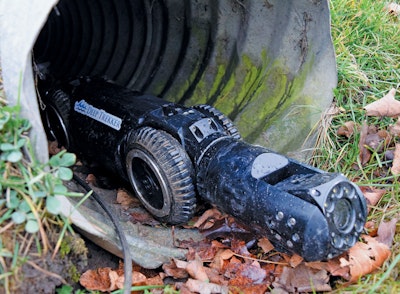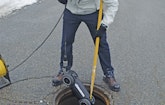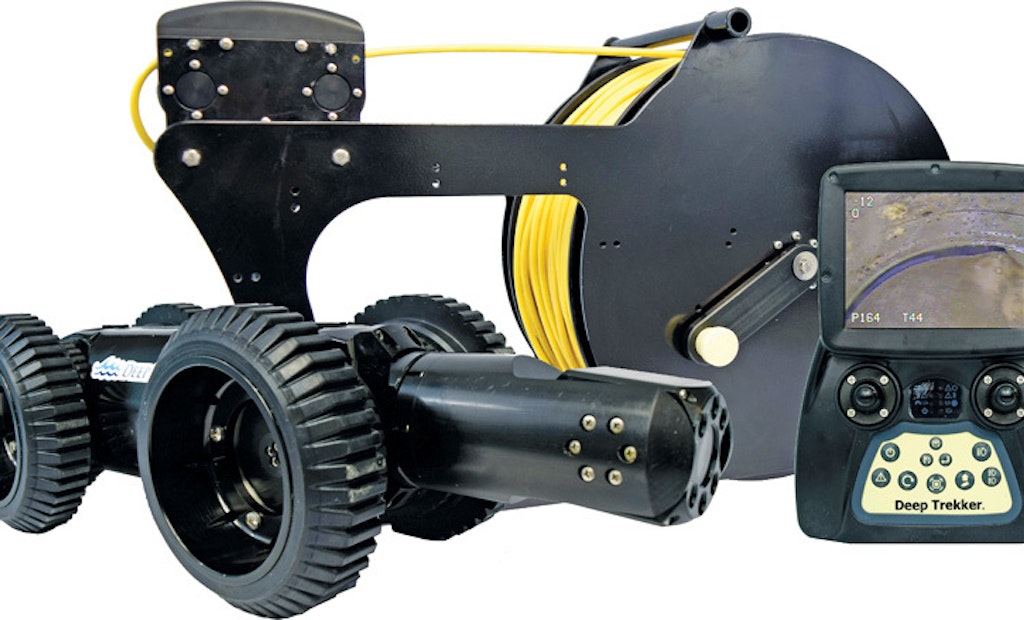Interested in Inspection?
Get Inspection articles, news and videos right in your inbox! Sign up now.
Inspection + Get AlertsA good inspection program can form a solid foundation for collections system acleaning, maintenance, repair, rehabilitation and replacement work. Thoroughly understanding the condition of your pipes is the key to addressing any potential issues, and the right camera system can make you more effective and efficient.
Choosing the right camera, however, isn’t always easy. Your collections systems include pipes of all different types, sizes, ages and conditions, and cameras aren’t one size fits all. Push cameras can navigate laterals, larger crawler setups can take on your mains, and pole cameras can give you a look inside manholes and provide zoom assessment. If you need to inspect pipes with remote or submerged access points, the portable and submersible Deep Trekker DT340 may be worth considering.
Deep Trekker’s Kiara Vallier took the time to discuss some of the unit’s features with MSW.
What was the idea behind the DT340?
Vallier: We have been working with service companies, municipalities and commercial divers since 2010, providing mini remotely operated vehicles that are used to perform underwater inspections. Infrastructure is aging, especially in North America, so it’s important that it be inspected regularly, which made our ROVs the go-to tool because of their simple platform and immediate deployment time.
As our company grew, our customers were looking for a similar solution that could crawl through pipelines. That’s when we took our innovative ROV technology and used it to build a highly capable, portable and submersible pipe crawler system. We made the system affordable for small municipalities and businesses, removed the requirement to have a dedicated truck, included batteries inside the crawler, and provided live controls and video to a hand-held controller.
What distinguishes this system from other portable inspection systems?
Vallier: All other pipe crawlers in the market require topside power. So even when they are said to be portable with a hand-held controller, they do require a topside connection. The DT340 Pipe Crawler System is 100 percent portable. It features internal lithium-ion batteries that last from four to eight hours on a 1.5-hour charge. This means that when operators have a hard-to-reach access point (for example in a remote area or from within a room where a door needs to remain shut) they can deploy the DT340 Crawler System within five minutes, with no additional logistics to worry about.
Deep Trekker’s pipe crawler is also the only portable pipe crawler system that is submersible up to 50 meters deep. This means that underwater pipelines with submerged access points are no problem for the DT340 Pipe Crawler.
Is this designed to be an all-in-one system for everything a utility might need to inspect?
Vallier: The system is designed to help operators inspect various pipe systems. Paired with our mini ROV systems, users have a complete inspection package capable of handling all underwater inspections on site, including pipes and tanks. The DT340 Crawler System is used to check for any abrasions, leaks, dents, cracks, sediment build up, blockages, etc.
What pipe sizes can the system effectively inspect?
Vallier: The standard system comes with wheels that allow it to inspect 8-inch pipes.
With larger wheels, the camera head can be positioned in the center of 10- and 12-inch pipes as well. Beyond this, our elevating arm can position that camera head in the center of a 36-inch pipe. All of the wheels are steerable for easy maneuvering around obstacles and turns within the pipe.
What’s included with the DT340?
Vallier: Everything you need to complete your pipeline inspection comes in two carry cases. With the DT340 Pipe Crawler System you receive the pipe crawler with a static or pan/tilt/zoom camera head, 492 feet of tether on a reel, tether length counter, two carry cases and an easy-to-use hand-held controller with a viewing screen. In addition, tether lengths can be customized up to 1,300 feet.
How is video recorded and shared?
Vallier: Using a composite RCA out the back of the controller, a DVR is used to record what the crawler sees right to an SD card. Alternatively, with one data cable, the feed can be brought into any recording device or laptop to record the information through inspection software such as WinCan.
How many feet of pipe can the system cover on a single charge?
Vallier: The batteries last from four to eight hours on a single 1.5-hour charge, so operators find they complete a full day of inspections with the system. The exact number of feet the DT340 crawler can cover depends on the driving conditions (speed, current, blockages, etc.) System inspections would range from 9,000 to 33,000 feet on a single charge.
How does underwater operation affect video quality?
Vallier: Before venturing into the world of pipe crawlers, we established ourselves by making robust and capable ROV systems meant for under-water viewing. A lot of the ROV features such as a low-light HD camera designed for underwater viewing, and strong lighting, translated very well to the pipe crawler systems. Anytime something is being inspected underwater there is a slightly lower video quality compared to dry inspections, but the DT340 crawler is a very capable underwater inspection tool.









